Things to Do in Playa Del Carmen on Mexico’s Yucatan Peninsula
14 min readOnce a modest fishing village, Playa del Carmen is a thriving coastal resort town along the Yucatan Peninsula in Mexico. Whether you’re looking for a relaxing day lounging in the sun or an adventurous day of snorkeling and scuba diving, Playa del Carmen has it all. With miles of Caribbean shoreline to choose from, it won’t be hard to find your own little slice of paradise here.
Key Takeaways
- Playa del Carmen holds a rich history of ancient civilizations and their cities, conquistadors and pirates, and Mexican independence.
- Take your time or take it all in at once—there are tours and guides for nearly every experience in and around Playa del Carmen.
- Nature lovers and archaeology buffs will both be in heaven in the beautiful expanse of mangrove trees and ancient Mayan ruins nestled into the rainforest.
- Don’t forget to pack your snorkeling gear; there are hundreds of scuba diving and snorkeling spots dotted around Playa del Carmen and the entire Riviera Maya.
Exploring the Beaches
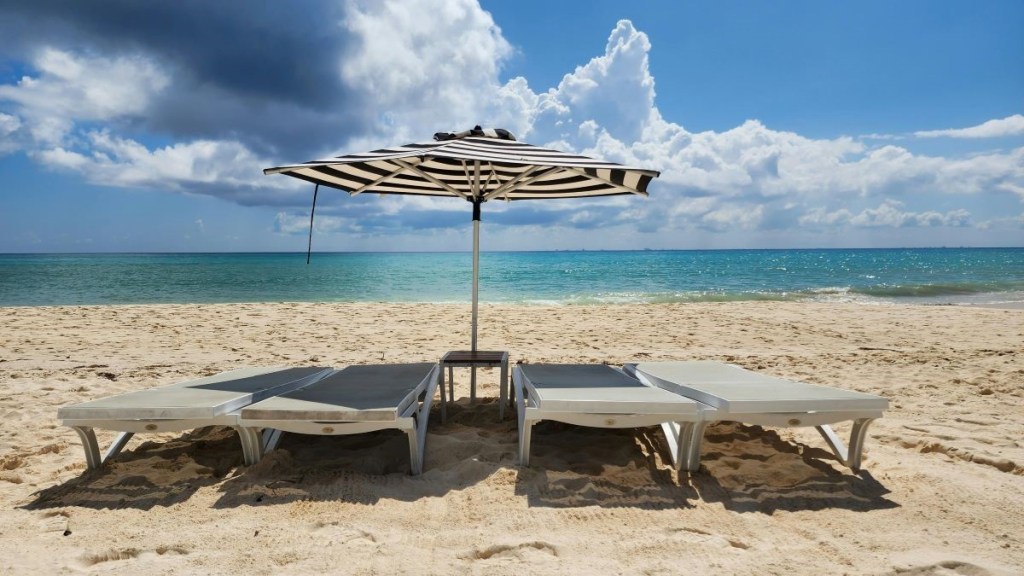
A private beach in Playa del Carmen, Mexico
Photo credit: Hugo Teconecta
White Sand Beaches
Playa del Carmen is home to some of the most breathtaking white sand beaches in the world. The crystal-clear waters and soft, powdery sand make it the perfect destination for any beach lover. Experience exquisite white sand beaches lined by turquoise-colored waters and coral reefs teeming with beautiful tropical fish. The perfect getaway for any beach bum, there are miles and miles of pristine beach to find your personal slice of heaven.
Whether you’re looking to sunbathe, swim, or simply relax, Playa del Carmen offers miles and miles of pristine beaches, perfect for all your beach getaway needs. From the bustling beach clubs to the secluded coves, there’s a spot for everyone to find their paradise. And if you’re a fan of snorkeling or scuba diving, the coral reefs around Playa del Carmen are teeming with sea life just waiting to be discovered.
Playa Paraíso
One of the most beautiful beaches in Mexico is the Playa Paraíso. It’s also the most popular beach among tourists, but with its vast stretches of sandy coast, you won’t feel overcrowded. Rent a pair of beach lounge chairs, a table, and an umbrella for 200 pesos, or grab your snorkeling gear and head for the water. This beach is family friendly, budget friendly, and picturesque.
Playa Ruinas
For the history buffs and culture-curious, the Playa Ruinas lies just tens of feet beneath ancient Mayan ruins and stunning rock formations. Sitting a walking distance from the ancient ruins of Tulum, the beach offers excellent views as well as snorkeling hotspots. The stairs can be quite a hike but well worth the extra effort for views from below as well as above. Book your tour of the ruins in the morning and cool off with a dip in the water below.
Akumal Beach
If you’re looking for the picture-perfect getaway, look no further. This incredibly scenic beach features classic island-style thatched (or palapa) roofs with a wide variety of bars and restaurants to meet your beach-day wants and needs. By rental car or bus, Akumal Beach is about 30 minutes away from central Tulum and well worth the trip. Sea turtles are known to make their way to this beach, so bring your snorkel gear and underwater cameras, but don’t get too close. Respect the wildlife by observing them from a comfortable distance.
Akumal Beach is also home to the most day clubs, all-inclusive resorts, and restaurants. This part of town is more developed and commercialized, so if you’re looking for the party, here it is. Hop into one of the rooftop pools or join in on the salsa dancing; there is sure to be live music and entertainment all day and all night.
Secret Beach
For those who are more adventurous and wanting to get away from the crowds, pack your bags and bike to the Secret Beach. This ruggedly beautiful beach is found in the Sian Ka’an Biosphere, a UNESCO World Heritage nature park located to the south of Tulum. The sprawling biodiverse park is home to crocodiles, dolphins, and turtles and welcomes visitors via a scenic two-hour boat tour. Or, rent a bike and bike about a mile to the Secret Beach, where you’re more likely to be sharing the beach with an iguana than other tourists.
Beach Clubs and Day-Trip Excursions
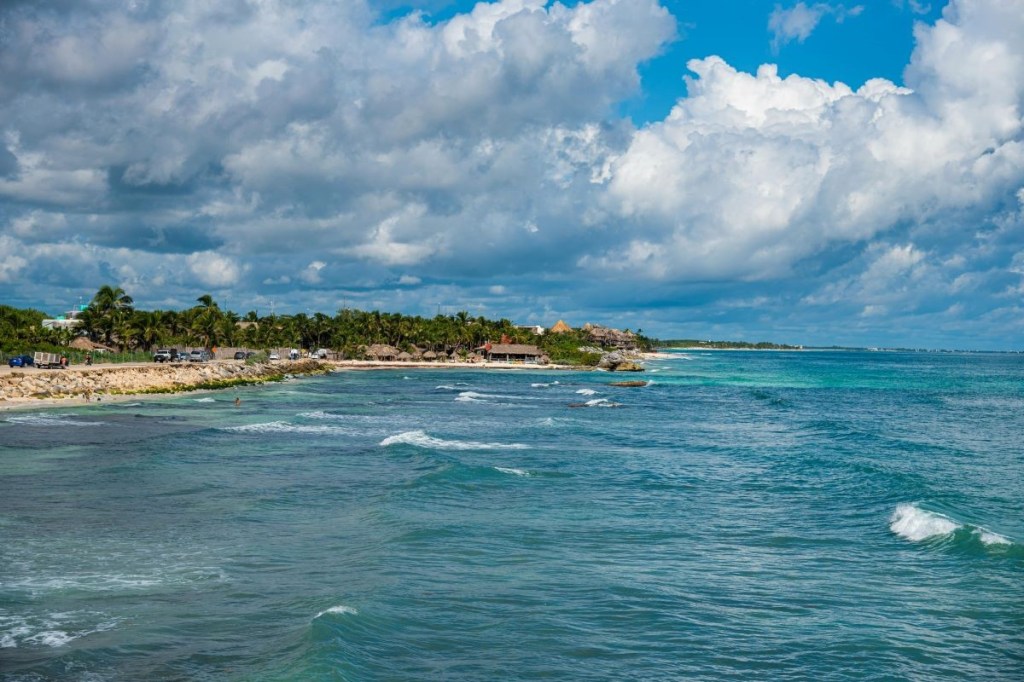
Views across the water to Tulum, Mexico
Photo credit: Edgar Del Valle
Tulum is becoming a well-known cruise and resort hotspot, so, naturally, beach clubs and day excursions are popping up to accommodate the increase in tourism. These popular beach clubs offer a variety of amenities, including lounge chairs, umbrellas, bars, restaurants, and even live music and entertainment.
One of the most popular beach clubs in Tulum is Papaya Playa Project, which is known for its bohemian vibe and laid-back atmosphere. The club offers a variety of activities, including yoga classes, beach volleyball, and even movie nights on the beach.
Another popular beach club is Ziggy’s Beach Club, which is located on a quiet stretch of beach and offers a more upscale experience. The club features a restaurant serving fresh seafood and other local specialties, as well as a full bar and lounge chairs for relaxing in the sun.
For those looking for a more eco-friendly option, Ahau Tulum is a great choice. This beach club is located on a beautiful stretch of beach and features a variety of sustainable practices, such as using solar power and composting food waste. The club also offers a variety of wellness activities, including yoga classes and spa treatments.
No matter which beach club you choose, you’re sure to enjoy the beautiful beaches and warm waters of Tulum in style and comfort.
For those who want to see it all, there are guided day-trip excursions that will take you to multiple scenic locations and feature a wide range of activities. From ziplining to snorkeling, jet skiing to scuba diving, or even all of the above, there are tailored experiences to suit everyone’s style.
Book a round-trip, eight-hour excursion including a guided tour of the ancient walled city of Tulum and surrounding archaeological sites, snorkeling, and swimming with sea turtles at Akumal Beach, plus a scenic drive along the Riviera Maya. Or take a guided tour through the mangroves and pink lagoons of Las Coloradas.
Another day-trip excursion offers a stunningly scenic tour perfect for bird watchers and nature lovers through Rio Lagartos, a crocodile reserve, and Las Coloradas, where you can see flamingos, cormorants, herons, and pelicans soaring above the unique pink lagoons.
For those looking to immerse themselves in the culinary culture of the region, there are Mexican cooking classes available. Spend the day learning to make authentic Mexican dishes with a guided tour of the local markets, demonstrations by local culinary masters, and a shared, home-cooked meal. No matter the weather forecast, rain or shine, there are plenty of day trips available to experience Playa del Carmen your way.
Isla Mujeres and Its Pristine Beaches
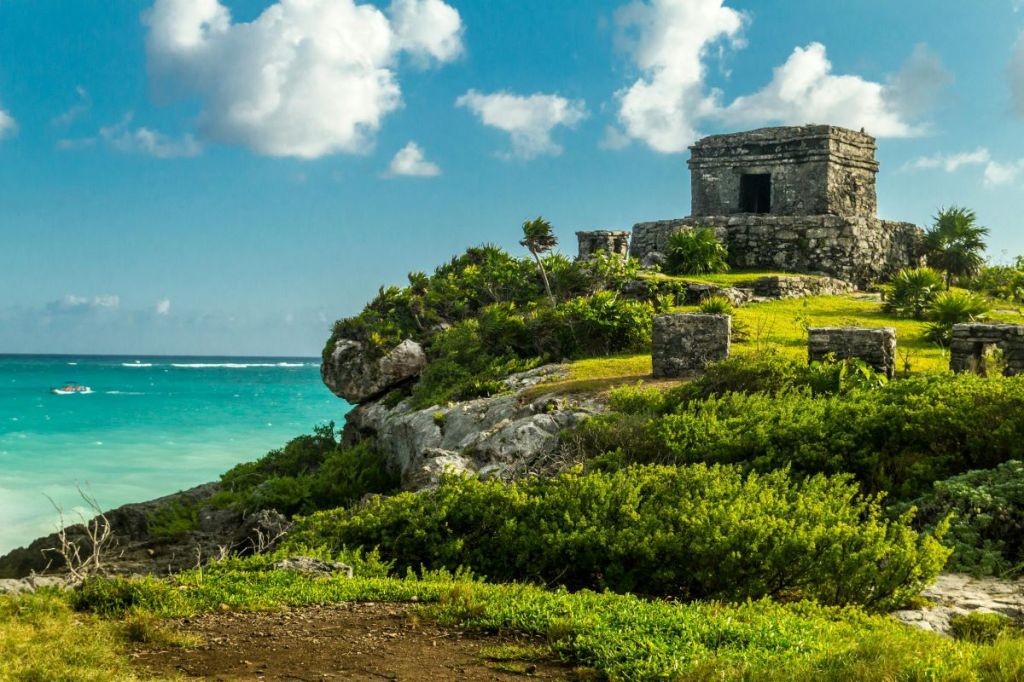
Mayan ruins in Tulum, Mexico
Photo credit: Samuel Sweet
Just a short 8 miles (13 km) from Cancun is the Isla Mujeres. The Mayans considered this island sacred and built a temple to the goddess Ixchel (pronounced ee-shl), the goddess of the moon, fertility, happiness, and medicine. Legend has it that the only inhabitants of the island were Ixchel and her handmaidens. The temple dedicated to Ixchel lies on the southern end of the island, where it was used as a lighthouse for ships passing by. Torches were lit inside the temple and could be seen through the patterned lattice sides. When the Spaniards came in the 16th century, they found a temple full of statues and images of the goddess and thus called it Isla Mujeres or “Island of Women.”
There are many legends and myths surrounding Isla Mujeres, not least of which are great pirate tales. Located between the Caribbean and the Gulf of Mexico, Isla Mujeres was known to be frequented often by pirates and conquistadors alike. Famous pirates such as Jean Lafitte and Henry Morgan (aka Captain Morgan) are rumored to have buried their treasure at the beautiful beaches of Isla Mujeres.
A famous landmark on the island is the grave of the (alleged) pirate Fermin Antonio Mundaca y Marecheaga. According to the widely regarded tale, Mundaca fell in love with a local woman named Martiniana Gomez Pantoja, whom he declared to be the most beautiful woman on the island. He spent a great amount of his fortune buying nearly half of the island to build a sprawling hacienda, planting a large garden, and even importing exotic animals from all over the world to build a private zoo—all to impress the beautiful Martiniana. Ultimately, she did not fall in love with him and married another. He is believed to have died of a broken heart, listing away in his hacienda all alone. His grave is frequented by many tourists who find the tale romantic and intriguing.
Today, this island contains a few resorts and hotels but remains secluded and remote, perfect for those who want to get away from the hustle and bustle and experience the slow life. You can get around like the locals do and rent a golf cart, scooter, or bike. There are very few cars on the island and these options are the preferred methods of transportation. The island can also be crossed on foot, as it is only 5 miles at its longest stretch. Enjoy the nearly untouched beaches as they are meant to be experienced—at a leisurely pace. Relax and enjoy the white sand beaches, crystal clear waters, and the friendly locals.
For those interested in the views below the sea at Isla Mujeres, there are day trips and tours available. Snorkeling and scuba diving are the most popular excursions on the island, thanks to the more than 20 dive sites around Isla Mujeres. Explore sunken ships, caves, and coral reefs, some of which are home to the famous Underwater Museum of Art. Enjoy an all-inclusive snorkel trip with a curated itinerary of snorkeling, guided boat tours, and lunch at a beach club, all for one price. Sail on a catamaran around the gorgeous, sparkling waters and take in the views around the island or wait until the magic hour and catch the sunset over the Caribbean.
Playacar Beach and Its Turquoise Waters
Playacar Beach is an exclusive gated resort community located to the south of Playa del Carmen. This beautiful stretch of white sand beach is the perfect destination for those looking to relax and unwind in a luxurious and tranquil setting. The crystal-clear waters of the Caribbean Sea are perfect for swimming, snorkeling, and other water sports.
However, the waters off of Playacar Beach have minimal natural breakwaters, so weather can greatly affect whether or not it is safe to swim there. Check the weather forecast and stay out of the water when the waves get too high.
Further to the south of Playacar Beach is the secluded Inah Beach. Surrounded by large rock formations, this small bay boasts great snorkeling, swimming, and a more secluded atmosphere.
Puerto Morelos—An Oasis of Relaxation
The once-small fishing town of Puerto Morelos is located just 30 minutes north of Playa del Carmen and 20 minutes south of the Cancun Airport. It is an oasis of fun and relaxation for those who want to get away from the big city without giving up any of the amenities. A favorite destination for hobby and professional fishermen, this town hosts annual fishing tournaments that attract big crowds. The hotels in town are quaint but immaculately maintained; most have 40 rooms or less. If you’d like to stay here, it’s best to book a room in advance.
Puerto Morelos lies along the Mesoamerican Barrier Reef—second only to the Great Barrier Reef in Australia. The reef at Puerto Morelos lies a mere 400 meters from shore, just below the surface, making it easily accessible to families with younger children or less experienced swimmers. The town is also along the longest underground river system in the world, known as the Great Mayan Aquifer. Experience Puerto Morelos’ famous Ruta de los Cenotes, a route that follows more than 60 mystic open-air pools or underground cave lakes.
For those seeking more adventure, the jungle lies just outside of Puerto Morelos. There are plenty of exciting activities to experience, such as ATV tours, mountain biking, ziplining, and horseback riding. You can even end your zipline circuit by diving or rappelling directly into a cenote, an experience only to be had in Mexico. The wildlife of the jungle is its own adventure, not to be overlooked. Nature lovers can meet the local fauna at the Crococun Zoo, a wild animal sanctuary that houses crocodiles, spider monkeys, and various parrots. Or you can take a stroll through the 160-acre Dr. Alfredo Barrera Marín Botanical Garden and take in the fascinating mangrove forest and ancient trees.
Historic Sites and Ruins
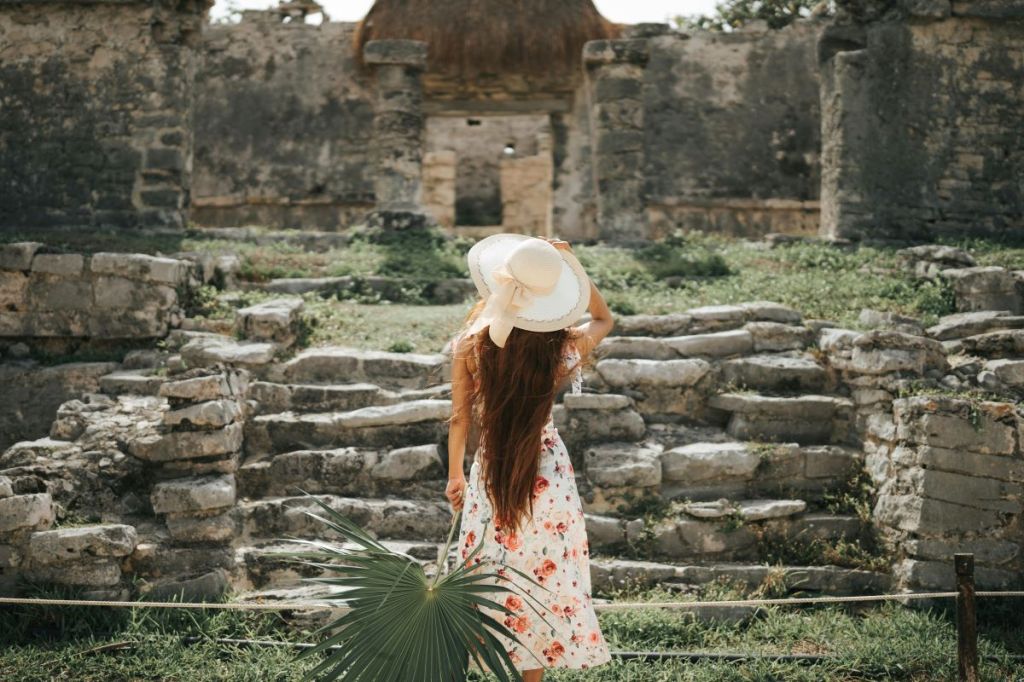
House of the Halach Uinic at Mayan Ruins in Tulum, Mexico
Photo credit: Joel Zar
The Mayan Ruins of Tulum
Standing proud on a cliffside almost 40 feet (12 m) above the Caribbean Sea, the Ruins of Tulum are a wonder to behold. Tulum was one of the last cities the Mayans occupied. Thought to be originally constructed as far back as 564 AD, it is now one of the best-preserved sites of the Mayan Empire and a top tourist attraction.
During its height in the 13th and 14th centuries, Tulum served as a major trading post for its neighboring city-states of Chichen Itza (one of the new seven wonders of the world), Coba, and Ek’ Balam (see both below). With walls on three of its sides and the Caribbean on the remaining side, Tulum was built to be a fortress. The town was used as a major gateway, connecting the peninsula of Yucatan with the further reaches of Central and South America. When the Spanish conquistadors first laid eyes on Tulum, they marveled at its sophistication, comparing it to Seville. Although it was inhabited for more than seven centuries, disease brought by the Spaniards decimated the majority of the population and the city was abandoned.
Take in the rich history of the area and see the same views the Mayans saw. The Tulum ruins are open every day from 8 a.m. to 5 p.m. Entrance is free on Sundays and only 80 pesos ($3-4 USD) for those entering without a tour. You can take a scenic 10-15 minute walk up to the archaeological site or take a train imbued with folklore for only $1 per person. Guided tours are available on site, or third-party tour options can be booked ahead of time. The ruins take around two hours to fully experience and are well worth the journey.
Coba: The Last Ancient City to Be Built by the Maya Civilization
Coba is another ancient Mayan city located in the Yucatan Peninsula of Mexico and is considered to be the last city built by the Mayan civilization. The city was built around two lagoons in the middle of dense tropical jungle, which still covers much of the surrounding area today. The city was estimated to have a population of around 50,000 people at its peak and was a major center for trade and commerce in the region. Unlike other Mayan cities, Coba was not built to be a ceremonial center but rather as a hub for trade and commerce.
One of the most impressive features of Coba is the Nohoch Mul Pyramid, which stands at over 42 meters tall and is one of the tallest Mayan pyramids in the Yucatan Peninsula. Visitors can climb to the top of the pyramid to enjoy panoramic views of the surrounding jungle. In addition to the Nohoch Mul Pyramid, Coba is also home to a number of other impressive structures, including the Macanxoc Group, the Coba Ballcourt, and the Coba Observatory. Visitors can explore the city on foot or rent a bicycle to cover more ground.
Coba is a fascinating archaeological site that provides a glimpse into the ancient Mayan civilization and its culture. It’s a must-visit destination for anyone interested in history, culture, and archaeology. Tours are available for those who wish to see Coba and even climb Nohoch Mul, the tallest pyramid in the area. Because the ruins of Coba are concentrated to a smaller area, tours often combine with a trip to the Tulum ruins and a dip in a cenote afterwards. It’s up to you whether to do a package deal or visit at your own pace.
Ek’ Balam: A Mysterious Place Surrounded by Mounds
Travel back in time to the ancient and mysterious Mayan city of Ek’ Balam. Ek’ Balam means “black jaguar,” and it is believed that the city was named after this animal due to its significance and importance to the Mayan Empire. At its height from 770 to 840 CE (Common Era), Ek’ Balam was an important center of trade and especially rich in pottery and ceramics.
This city was only recently rediscovered and was in good condition, making it a wealth of information for archaeologists. Extensive restoration work has been done to preserve and maintain its elaborate stucco facade, architecture, and wall paintings. The most notable structure at Ek’ Balam is the Acropolis. The Acropolis is the largest structure at the site and is believed to have been home to the city’s rulers. It contains many stunning works of art and historical texts written and carved that describe the history of the rulers and of Ek’ Balam itself.
Ek’ Balam is surrounded by large, unexcavated mounds to the east and west. They may contain ceremonial or other important burials, but until archaeologists can excavate these mysterious sites, no one knows their function or purpose. Another structure is the Ball Court, one of the largest playing fields of the ancient Mayan Empire. It is surrounded by intricate carvings and sculptures that depict the history and mythology of the Mayan culture.
Visitors can explore the city’s many temples, palaces, and other structures that are well preserved and full of elaborate decorations. There are stories to be interpreted in its walls and numerous jaguar motifs around the structures that are waiting to be found and photographed.
The central plaza of Ek’ Balam is also a great place to sit and take in the grandeur, sights, and sounds of this ancient Mayan city. The historical site is open every day from 8 a.m. to 5 p.m. and visitors are allowed to enter on their own or as part of a tour group. The entrance fees to Ek’ Balam are a bit higher than the other ruins, as visitors are asked to pay state and federal fees as well.
As with Coba, tours are often bundled with other experiences to give you a full day’s worth of activities, often including lunch and a dip in a cenote after a long day of hiking up pyramid stairs in the heat of the jungle.
Underground Cave (Cenote) Swimming Experience
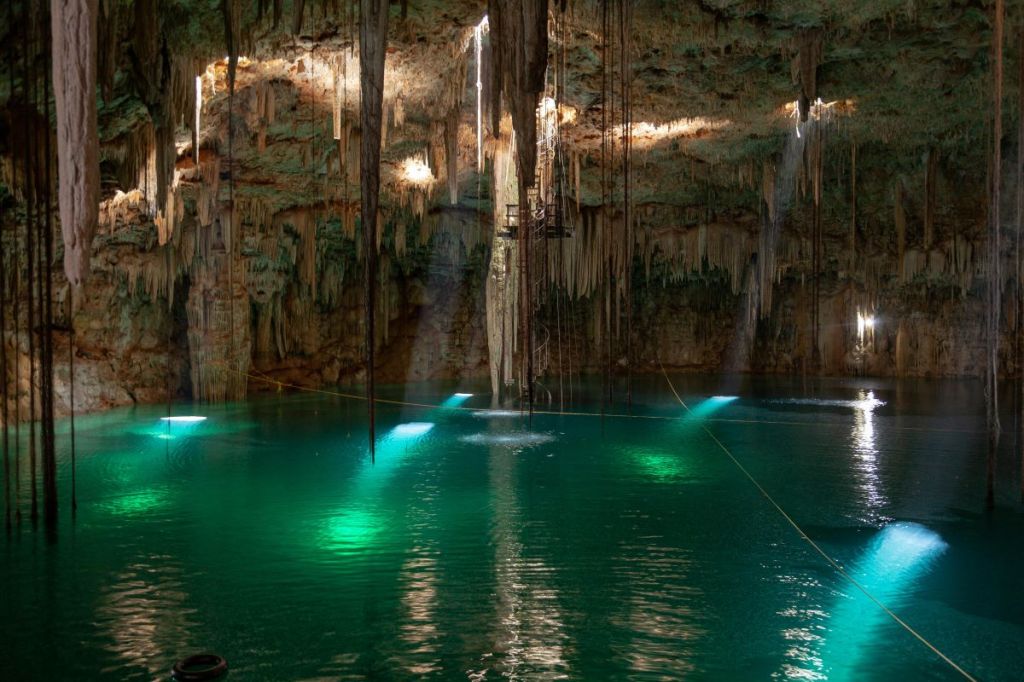
A cenote in Yalcobá, Yucatan, Mexico
Photo credit: Mauricio Borja
Visiting Playa del Carmen wouldn’t be complete without seeing an underground cave, or cenote, in person. Cenotes are natural sinkholes filled with crystal-clear fresh water, often found in underground caves or open-air formations. Exploring a cenote is a surreal experience, as you swim, snorkel, or even scuba dive through the clear water of the underground rivers and marvel at the rock formations and underwater stalactites. Some cenotes even have zip lines or cliff-jumping opportunities for the adventurous. It’s a truly unforgettable experience that shouldn’t be missed if you’re visiting Mexico.
Cenotes are not only beautiful but also significant in Mayan culture. The ancient Mayans believed that cenotes were sacred portals to the underworld, and they often used them for sacrificial offerings. Today, many cenotes still hold a spiritual significance to the local people, and there are some cenotes that are only accessible with permission from the local Mayan communities. Cenotes are revered for their mystical healing power and are certainly an experience to be cherished and respected. My advice is to get to the cenote early to enjoy the quiet morning stillness and peacefully bathe in the wonder and magic.
Visiting a cenote is a must-do experience for anyone traveling to the Yucatan Peninsula, as it provides a unique opportunity to explore the natural beauty and cultural history of the region. With so many cenotes to choose from, there’s sure to be one that aligns with your interests and ignites your sense of adventure.



